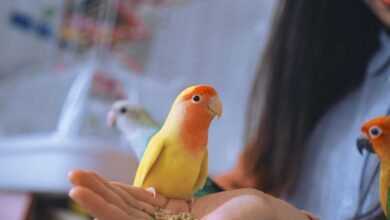Chirps to Speech: Mastering Bird Talking Training

Understanding the Basics of Bird Talking Training
Introduce readers to the concept of teaching birds to talk. Explain that not all bird species are equally proficient at mimicking human speech and discuss the importance of choosing the right bird for talking.
Selecting the Right Bird for Talking
Provide guidance on choosing a bird species known for its ability to mimic human speech, such as African greys, Amazons, or budgies. Emphasize that individual personalities also play a role in talking ability.
The Importance of Socialization
Socialize your bird with family members, other pets, and even acquaintances. Exposure to different voices and environments encourages speech development and confidence in communication.
Creating a Bird Talking Training Schedule
Detail the importance of consistency in training and encourage readers to establish a daily schedule for training sessions. Explain that short, regular training sessions are more effective than infrequent, lengthy ones.Start with 10-15 minute sessions and gradually extend them as your bird becomes more comfortable.
Unlocking the Language of Feathers: Teaching Birds to Talk
Training Methods and Techniques
Discuss different methods for teaching birds to talk, such as repetition, modeling, and using positive reinforcement. Provide step-by-step instructions for each method.
Repetition Method: A Closer Look
The repetition method involves repeating specific words or phrases clearly and patiently. Start with simple, commonly used words like “Hello” or “Hi there.” Use a gentle, friendly tone to encourage participation. Consistency is key; practice these words regularly.
Modeling Method: Tips and Tricks
With the modeling method, you demonstrate the words and phrases you want your bird to learn. Speak the desired words clearly and repeatedly in front of your bird. Allow them to observe and imitate.
Positive Reinforcement: The Key to Motivation
Positive reinforcement is essential in bird talking training. Reward your bird with their favorite treats or enthusiastic praise when they successfully mimic speech. Consistently reward correct attempts to reinforce desired behavior.
Choosing Your First Words
Guide readers on selecting simple and commonly used words or phrases to start with, as these are easier for birds to mimic. Encourage using clear enunciation and a friendly tone during training. Begin by introducing a cue word or gesture, such as saying “Talk” while training. Make sure your bird associates this cue with speech exercises.
Gradually Progressing to Phrases and Sentences
Explain how to build on basic words by combining them into short phrases and eventually complete sentences. Emphasize patience and consistent practice. For example, break down phrases like “Good morning” or “I love you” into smaller components. Practice these components and gradually combine them into complete phrases.
From Tweets to Speech: Your Guide to Bird Mimicry Training
Understanding Bird Mimicry
Explain that birds mimic sounds from their environment, which includes human speech. Discuss the cognitive abilities that allow birds to mimic sounds.
Mimicking Other Sounds
Highlight that birds can mimic more than just speech, such as the sound of a ringing phone, laughter, or even musical tunes. Encourage owners to recognize and reward these efforts.
Building Vocabulary for Your Bird
Share tips for expanding your bird’s vocabulary, such as introducing new words and phrases regularly. Reinforce the importance of consistency and repetition.
Conversations with Feathers: Train Your Bird to Speak
Training Your Bird to Talk on Command
Explain how to teach your bird to talk when prompted. This is especially helpful when showing off your bird’s skills to friends and family.
Working on Clear Enunciation
Clear enunciation is crucial for your bird’s speech to be understood. Practice pronunciation clearly and ensure your bird repeats with precision. This enhances the communicative abilities of your bird and prevents misunderstandings.
Patience and Consistency: The Training Bedrock
Patience is essential in bird talking training. Birds respond better in a relaxed atmosphere. Maintain a calm and patient demeanor throughout training. Use consistent tones and enunciation, and remember that each bird learns at its own pace. Consistency is the foundation of successful training; stick to the schedule and maintain a regular training routine.
Training Your Bird to Talk to Different People
Detail the process of encouraging your bird to speak in the presence of various family members or friends. Discuss how to make this a fun and interactive experience.
Training Your Bird to Talk in Different Situations
Explain how birds can learn to talk in specific situations, such as greeting guests or asking for food. Share tips on how to encourage context-specific speech.
Wings of Words: Teaching Your Pet Bird to Talk
Training for Fun and Companionship
Emphasize that teaching birds to talk is not only about the end result but also the bonding experience. Encourage readers to enjoy the journey and celebrate each small achievement.
Training for Practical Purposes
Discuss how teaching birds to talk can serve practical purposes, such as alerting to specific needs (e.g., food or water) or providing companionship for people with limited mobility. This skill can be especially valuable for individuals with limited mobility, adding a layer of practicality to your bird’s speech.
Fostering a Deeper Connection
Training your bird to talk is not just about words; it’s about building a deeper bond with your feathered friend. Use these sessions to strengthen your connection, reinforcing trust and understanding.
Overcoming Bird Talking Challenges
Addressing Shyness and Nervousness
If your bird appears hesitant or shy during training, be patient and adapt the training environment. Ensure a quiet, secure space free from distractions, gradually increasing the training duration as your bird gains confidence.
Dealing with Uncooperative Birds
Not all birds will immediately embrace talking training. If your bird is anxious or uncooperative, consult with an avian veterinarian or an experienced bird trainer. They can provide valuable insights and techniques to address specific challenges and obstacles.
By incorporating these detailed insights into your bird talking training, you can build a stronger connection with your pet bird and embark on an enjoyable journey of teaching them to communicate with you. Remember, patience and consistency are the keys to success in bird talking training.








